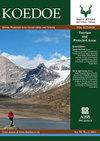A reclassification and description of the Waterberg Mountain vegetation of the Marakele National Park, Limpopo province, South Africa
IF 1.1
4区 环境科学与生态学
Q3 BIODIVERSITY CONSERVATION
引用次数: 4
Abstract
The description and classification of vegetation are important for conservation and resource management. The aim of this study was to identify, reclassify and describe the plant communities present in the Waterberg Mountain vegetation of the Marakele National Park in the Limpopo province, South Africa. A phytosociological classification, mapping and description of sections of the Waterberg Mountain vegetation in the park were done in 1995. Since 1995, various farms adjacent to the park have been bought and incorporated into it. Little is known about the vegetation and habitat status of these newly acquired areas, which led to this study. The floristic data were analysed according to the Braun-Blanquet procedure using the Braun Blanquet Personal Computer (BBPC) suite as well as the JUICE software package, whilst the diversity of the plant communities was determined using the Shannon–Wiener and Gini–Simpson indices. A total of 12 plant communities were identified and are described according to their diagnostic, constant and dominant plant species as determined from the synoptic table analysis as well as their characteristic species as derived from the phytosociological table. Based on the topography and plant species composition, the vegetation can be grouped into five major groups, namely the: (1) lower midslope and plateau shrub- and woodlands, (2) high altitude midslope woodland, (3) high-lying plateau and midslope grass-, shrub- and woodlands, (4) ravine, footslope and drainage line forests and woodland, and (5) higher-lying plateau wetlands and forblands. The high altitude midslope grassland and shrubland and the lower midslope and plateau areas have the highest diversity. The high-lying vegetation has affinity with Bankenveld and Drakensberg vegetation, whilst the relatively low-lying plateaus and midslope vegetation are typical of the bushveld areas.Conservation implications: This reclassification, mapping and description of the Waterberg Mountain vegetation have been incorporated into the Management Plan for the park. It will enable managers to make scientifically based decisions on the management of the different ecosystems to ensure biodiversity conservation. This vegetation study also provides baseline information that allows for vegetation assessments to determine veld condition, carrying capacity and stocking density for the park.南非林波波省Marakele国家公园Waterberg山植被的重新分类和描述
植被的描述和分类对植被的保护和资源管理具有重要意义。本研究的目的是鉴定、重新分类和描述南非林波波省Marakele国家公园Waterberg山植被中的植物群落。1995年对公园内的沃特伯格山植被进行了植物社会学分类、制图和描述。自1995年以来,公园附近的多个农场被收购并并入公园。由于对这些新获得区域的植被和生境状况知之甚少,因此进行了这项研究。利用Braun Blanquet Personal Computer (BBPC)软件和JUICE软件对植物区系数据进行了分析,利用Shannon-Wiener指数和Gini-Simpson指数确定了植物群落的多样性。共鉴定出12个植物群落,并根据天气表分析确定的诊断、恒定和优势植物种类以及植物社会学表确定的特征物种进行了描述。根据地形和植物种类组成,可将植被分为五大类群,即:(1)低中坡和高原灌丛林地,(2)高海拔中坡林地,(3)高海拔高原和中坡草、灌木和林地,(4)沟壑、脚坡和水系森林和林地,(5)高海拔高原湿地和滩涂。高海拔中坡草原和灌丛、低海拔中坡和高原地区多样性最高。高海拔植被与Bankenveld和Drakensberg植被有亲缘关系,而相对低洼的高原和中坡植被是灌木原始区的典型植被。保护意义:对沃特伯格山植被的重新分类、制图和描述已纳入公园的管理计划。它将使管理者能够对不同生态系统的管理做出基于科学的决策,以确保生物多样性的保护。这项植被研究还提供了基线信息,用于植被评估,以确定该公园的草原状况、承载能力和放养密度。
本文章由计算机程序翻译,如有差异,请以英文原文为准。
求助全文
约1分钟内获得全文
求助全文
来源期刊

Koedoe
BIODIVERSITY CONSERVATION-
CiteScore
3.30
自引率
0.00%
发文量
10
审稿时长
20 weeks
期刊介绍:
Koedoe, with the subtitle ''African Protected Area Conservation and Science'', promotes and contributes to the scientific (biological) and environmental (ecological and biodiversity) conservation practices of Africa by defining the key disciplines that will ensure the existence of a wide variety of plant and animal species in their natural environments (biological diversity) in Africa.
 求助内容:
求助内容: 应助结果提醒方式:
应助结果提醒方式:


